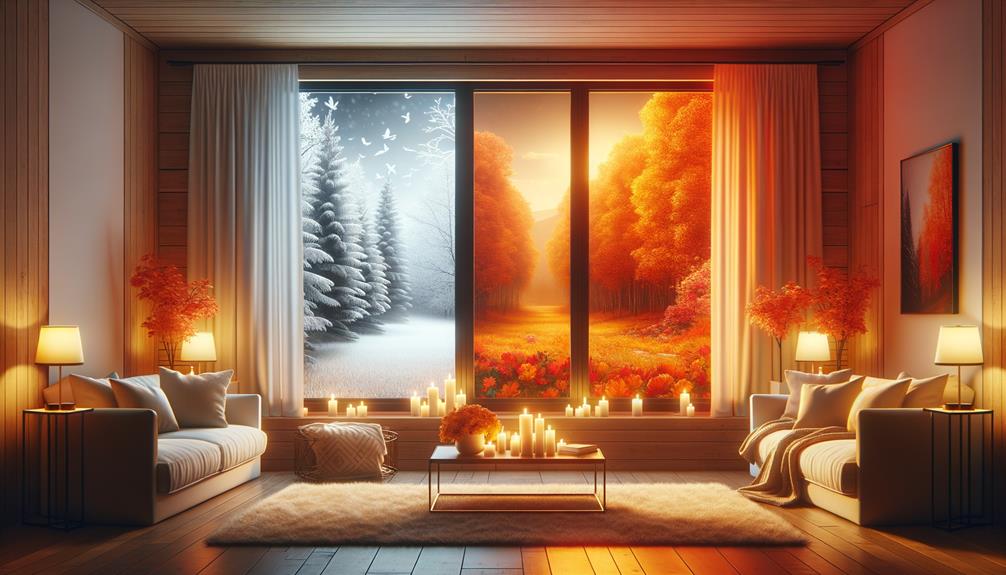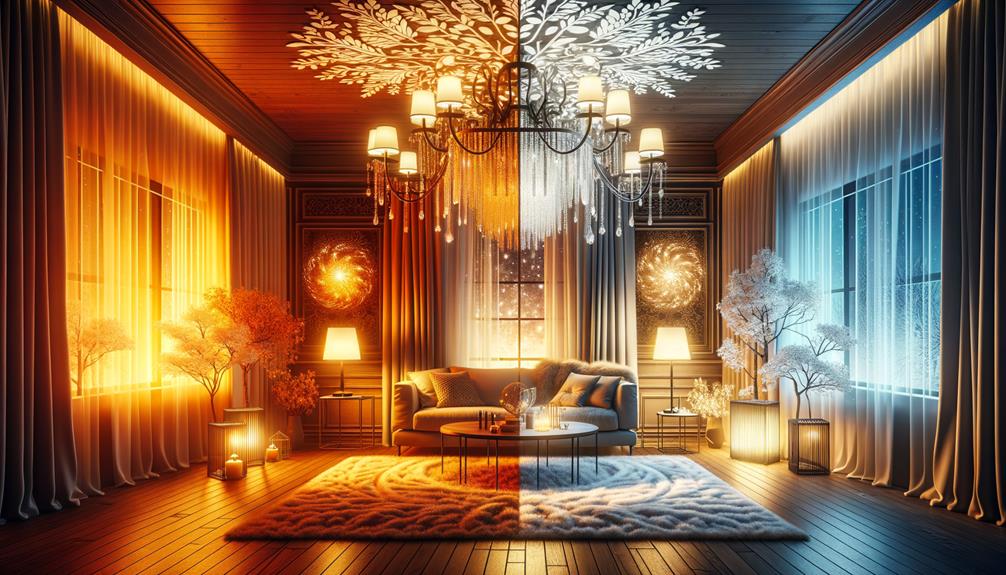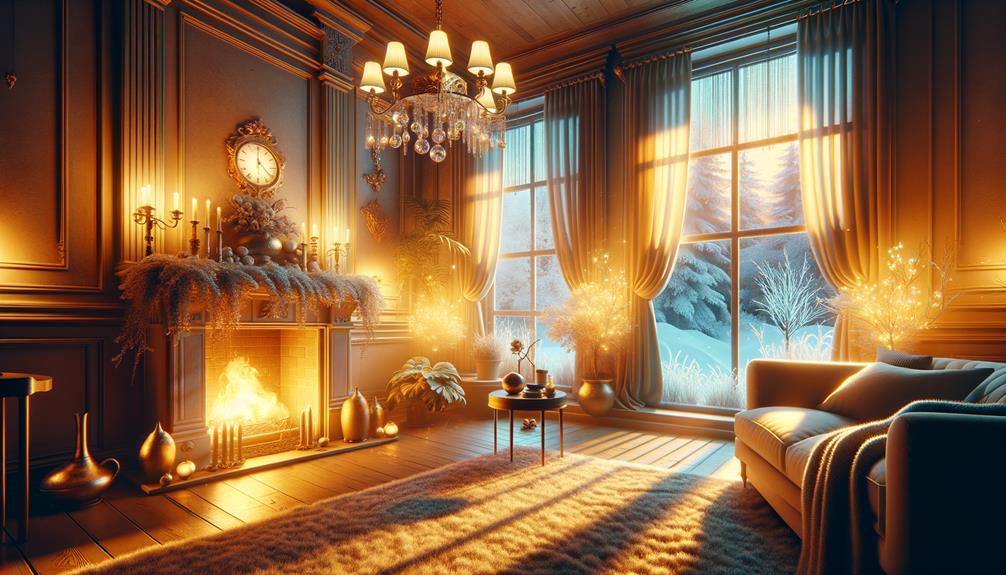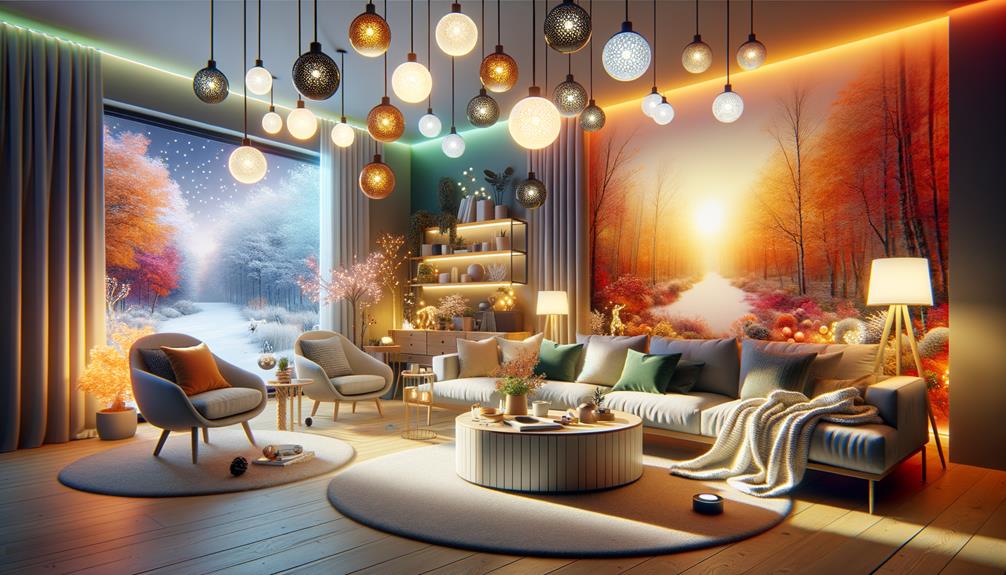Seasonal lighting changes are vital for creating a comfortable and functional environment. As the seasons shift, adjusting lighting to match the changes enhances space perception and boosts energy efficiency. By using light and motion sensors, along with controlling window shades, you can ensure ideal brightness and minimize glare. When days grow shorter in winter, adequate illumination becomes crucial for safety. Balancing light levels with environmental needs supports overall well-being. As sunlight changes with the seasons, shadow colors are affected, influencing the ambiance of a space. Selecting the right fixtures and bulb temperatures can greatly impact room aesthetics and mood. To optimize your lighting strategy, it's essential to consider the changing seasons and their impact on your space.
Key Takeaways
Seasonal lighting changes can greatly impact energy efficiency and visual comfort. By adapting lighting systems to seasonal changes, you can ensure the right amount of light at the right time.
Light sensors detect natural light availability throughout the year and adjust illumination accordingly. Motion sensors optimize lighting by detecting occupancy and changing daylight hours, which helps reduce energy consumption.
The color temperature of lighting also plays a significant role in creating a comfortable atmosphere. Warm lighting can enhance coziness during winter, while cool tones can boost productivity in summer.
Lastly, managing window shades helps regulate brightness and minimize glare across seasons. By adjusting shades according to the time of day and season, you can create a comfortable and energy-efficient indoor environment.
Importance of Seasonal Lighting
Understanding the importance of seasonal lighting changes is vital for creating a comfortable and functional living or working environment. As daylight hours shorten in winter, our lighting systems need to adapt to maintain visual comfort and energy efficiency.
Proper lighting directly affects how we perceive a space and how effectively we can use it. By incorporating light sensors, motion sensors, and shade controls, we can adjust lighting levels to match seasonal demands. This not only enhances visual comfort but also reduces energy consumption and costs.
Seasonal lighting adjustments also play a crucial role in safety. Adequate illumination during dark winter days prevents accidents and creates a secure atmosphere. Combining natural and artificial light sources ensures excellent lighting conditions, maximizing the ambiance and functionality of any space.
In essence, seasonal lighting changes are about finding a harmonious balance between light and environment, creating a space that supports both our practical needs and our desire for well-being.
Adapting to Seasonal Light

When adapting to seasonal light, I prioritize energy efficiency by using light and motion sensors. These technologies adjust lighting levels and occupancy needs, ensuring visual comfort throughout the year. To regulate brightness and minimize glare, I also manage window shades, which contributes to overall productivity and safety.
Seasonal Light Adjustments
Adapting our lighting systems to seasonal changes is a great way to save energy and ensure ideal visual comfort throughout the year. I use light sensors and motion sensors to make this happen. Light sensors automatically adjust lighting levels based on the time of year, so I get the right amount of brightness without wasting energy. During the longer summer days, they dim the indoor lights when there's plenty of natural light available. In the darker winter months, they brighten up the space to make up for the lack of daylight.
Motion sensors also play a key role. They control the lights based on when I'm in a room, adjusting to the changing lengths of days. For example, during the shorter winter days, they make sure the lights turn on as soon as I enter a room, so I don't have to deal with unnecessary darkness.
Managing shade movement is another important aspect of seasonal light adjustments. By adjusting the angle of sunlight entering through windows, shades can block harsh rays in the summer, reducing glare, and adjust downward in the winter to optimize surface brightness. This thoughtful adjustment helps maintain visual comfort and prevents eye strain.
Ultimately, adapting our lighting systems to the seasons is crucial for maintaining visual comfort, avoiding glare, and staying productive throughout the year.
Sensor-Based Lighting Control
Sensor-based lighting control is a game-changer for adapting to seasonal light changes. By using light sensors, I can automatically adjust the lighting levels in my space to match the amount of natural light available. This means that on sunny summer days, my artificial lighting dims, while on overcast winter afternoons, it brightens, maintaining a consistent and comfortable environment.
Motion sensors also play a key role in managing lighting efficiently. They detect occupancy and adjust lighting accordingly, which is especially useful as daylight hours fluctuate with the seasons. This ensures that lights are only on when needed, maximizing energy efficiency and convenience.
Controlling shade movement is another crucial aspect. By adjusting window shades, I can regulate brightness levels and prevent glare. During summer, shades block intense sun rays, while in winter, they can be positioned to let more natural light in, perfectly adapting to seasonal lighting needs.
Energy Efficiency Strategies
Optimizing energy efficiency during seasonal lighting changes is a sensible move that not only saves money but also greatly reduces environmental impact. Switching to LED lights is one of the most effective strategies I've found. These lights use significantly less energy and last much longer than traditional incandescent bulbs, making them an excellent choice for reducing energy consumption.
Using timers or motion sensors can further reduce energy waste. By controlling when lights are on, I can minimize energy waste and save money. Leaving lights on for less than eight hours a day also reduces light pollution and benefits wildlife conservation, ensuring that my seasonal lighting doesn't disrupt natural habitats.
Sustainable disposal of old lights is another crucial step. Recycling or upcycling prevents hazardous materials from ending up in landfills, contributing to environmental protection. Knowing that my old lights are being reused or safely disposed of gives me peace of mind.
Incorporating these energy efficiency strategies into my seasonal lighting routine allows me to enjoy festive decor without compromising on sustainability. It's a simple yet powerful way to take control of my energy use and make a positive impact on the environment.
Sunlight and Shadow Colors

When I take a closer look at sunlight and shadow colors, I notice how the effects of complementary colors change with the seasons. During summer and autumn, shadows appear more vibrant, while in the cooler months, they soften and become more diffused. The location you're in also plays a significant role in how these colors and intensities manifest throughout the year.
Complementary Color Effects
Exploring the effects of sunlight and shadows on interior spaces can greatly enhance our surroundings. The interplay of light and shadow, influenced by geographical location and seasonal changes, brings unique hues and contrasts to our daily lives.
In summer and autumn, vibrant colors and well-defined shadows create striking atmospheres, perfect for experimenting with bold decor and innovative lighting systems. On the other hand, the cooler months present softer, diffused shadow tones, inviting a more soothing ambiance.
| Season | Sunlight Colors | Shadow Colors | Emotional Impact |
|---|---|---|---|
| Summer | Vibrant | Sharp | Energizing, Exciting |
| Autumn | Warm | Defined | Cozy, Inviting |
| Winter | Soft | Diffused | Calm, Reflective |
| Spring | Fresh | Gentle | Renewing, Optimistic |
Seasonal Color Intensity
Here's the modified text:
The changing seasons and geographical nuances have a profound impact on the intensity of sunlight and shadow colors. Observing these shifts can be both fascinating and liberating, allowing us to appreciate the subtle beauty of our environment in different lights.
During the warmer months of summer and autumn, sunlight is more intense, casting sharper, more vibrant shadows. This creates a stark contrast between light and dark areas, making colors appear more vivid and shadows crisper.
In contrast, the cooler months of winter and early spring bring softer sunlight, resulting in more diffuse shadows that often display softer, complementary colors. These gentler hues blend more subtly with their surroundings.
The direction of your windows also plays a significant role in the colors and shadows inside your space. For instance, morning light from northeast-facing windows often brings in violet-to-blue hues, casting orange-to-brown shadows on white walls. Meanwhile, south and west-facing windows during sunset bathe the room in warm golden-orange and rose rays, casting beautiful purple and blue shadows.
Understanding these changes can enrich our experiences and interactions with our living spaces, empowering us to harness natural light to create the ambiance we desire.
Geographical Light Variations
Geographical location has a profound impact on the quality and color intensity of sunlight and shadows, shaping our perception of natural light throughout the year. The angle of the sun and the changing seasons dramatically affect the intensity and hue of these lights and shadows.
In summer and autumn, the sun's rays are more direct, resulting in sharper shadows and more vibrant colors. In contrast, winter's cooler months soften these effects, creating diffused, complementary shadows. Northeast-facing windows, for instance, catch morning lights with a violet-to-blue hue, casting orange-to-brown shadows. Meanwhile, south and west-facing windows bathe in warm golden-orange and rose rays during sunset, resulting in purple and blue shadows.
Here's how different window orientations impact light and shadow colors:
| Window Orientation | Morning Light Hues | Evening Shadow Colors |
|---|---|---|
| Northeast | Violet-to-blue | Orange-to-brown |
| South | Warm golden-orange | Purple |
| West | Rose | Blue |
Understanding these variations can help us appreciate the dynamic interplay between geographical location, seasonal changes, and natural light. It's not just about the lights themselves but also how the seasons transform our environment, providing a richer, more nuanced visual experience. This knowledge empowers us to harness these natural changes to enhance our living spaces.
Light Fixtures and Temperatures

When selecting light fixtures, it's crucial to consider the temperature of the bulbs to ensure they match the room's decor and desired atmosphere. Lighting fixtures and light temperatures significantly impact a room's aesthetic and functionality. For instance, classic filament bulbs offer warm lighting, creating a cozy and inviting ambiance, while fluorescent bulbs provide a range of warm to cool tones, ideal for complementing various decor colors.
When choosing fixtures, remember the following key factors:
- Type of Fixture: Pendants, chandeliers, and sconces each cast light and shadows differently, affecting the overall room's visual appeal.
- Bulb Temperature: Warm tones (around 2700K) create a relaxing atmosphere, while cool tones (up to 5000K) energize a space.
- Texture Emphasis: Fixtures can highlight textures and create intriguing shadow patterns on walls.
Lighting's Impact on Mood

Understanding the impact of lighting on mood is crucial for creating spaces that feel inviting and functional. Light colors and tones can transform a room's atmosphere, making it calming or energizing. For instance, warm lighting solutions often create a cozy, festive atmosphere, perfect for social gatherings. On the other hand, cooler tones can stimulate focus and productivity, ideal for workspaces.
Natural light plays a vital role, too. The way sunlight interacts with shadows can dramatically alter a room's mood throughout the day. In the morning, soft light can gently wake us up, while the golden hues of the evening create a relaxing ambiance. By harnessing this natural interplay, we can greatly enhance the space's overall ambiance.
When designing a space, it's vital to consider how lighting affects both functionality and aesthetics. Proper lighting can highlight architectural features or decor colors, reflecting our individual taste and style. By grasping these dynamics, we can make informed choices that align with our desired mood and atmosphere.
Ultimately, the right lighting solutions not only illuminate our spaces but also influence our experiences within them. Whether aiming for a festive atmosphere or a serene retreat, thoughtful lighting choices are key to achieving the desired emotional impact.
Personalized Lighting Design

Creating a personalized lighting design means thoughtfully selecting fixtures, bulbs, and controls to craft a unique atmosphere tailored to your specific tastes and needs. This approach can greatly impact the functionality, aesthetics, and mood of a space. To achieve this, consider the following steps:
- Select the Right Fixtures: Start by choosing fixtures that complement your room's design and serve the intended purpose, whether for reading, working, or ambiance.
- Adjust Color Temperature: Fine-tune the color temperature to suit the season and activity. Warm tones are perfect for the holiday season, while cooler tones might be better for focused tasks.
- Control Brightness Levels: Use dimmers and smart controls to adjust brightness levels throughout the day and for different occasions, such as dimming Christmas lights for a cozy evening.
Experimenting with different lighting options allows me to create a personalized and inviting atmosphere in my home. During the holiday season, I love incorporating Christmas lights to add a festive touch. By adjusting brightness and color temperature, I can set the perfect mood, whether it's a lively gathering or a peaceful night in. Personalized lighting design gives me the freedom to transform any space to fit my unique style and needs.
Frequently Asked Questions
What Is Seasonal Lighting?
Seasonal lighting is all about adjusting artificial light to match the natural light changes that happen throughout the year. By using light sensors, motion sensors, and shade controls, I can create an atmosphere that's just right, while also saving energy and ensuring visual comfort.
How Do Seasonal Variations Impact Light Intensity?
I've noticed how seasonal changes impact light intensity. In winter, days are shorter and light is dimmer, which is a stark contrast to summer's longer, brighter days. This shift affects both color temperature and ambiance, making it necessary to adjust lighting for comfort and productivity.
What Is the Voltage of Trimlight?
Trimlight operates at a low voltage of 12 volts, which ensures energy efficiency, safety, and ease of installation. This low voltage also allows for flexibility in design and placement, contributing to the system's reliability and long lifespan.
What Does Light Do?
Light fundamentally changes how I experience colors, shadows, and textures. It adds depth and visual appeal, creating a distinct atmosphere in any space. By controlling light effectively, we can enhance both functionality and aesthetics, making environments more captivating and engaging.



